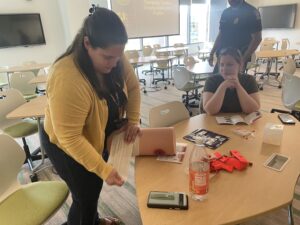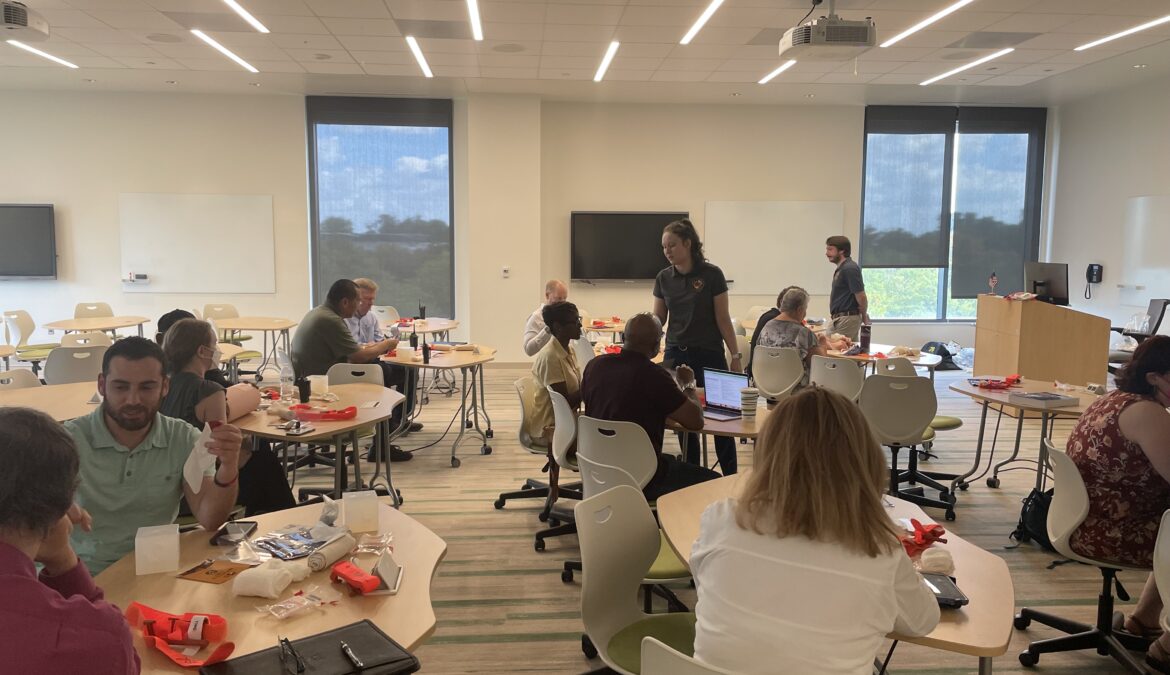In October, the Maryland-National Capital Region Emergency Response System (MDERS) led two Public Access Trauma Care (PATC) training events at the Universities at Shady Grove (USG). The trainings provided instruction on identifying severe medical injuries and applying the proper treatment for those injuries. Hosting these training opportunities provided participants with invaluable experience in practicing the basic PATC skills, empowering them to provide immediate aid to an injured victim.
Prior to instruction on medical aid, the course began with an overview of key aspects to consider before rendering care to a victim. First, participants learned how to communicate effectively with 9-1-1 dispatchers by directly calling 9-1-1 or commanding another bystander to do so. Participants were urged to be proactive and not assume someone has already called 9-1-1. Articulating clear information and responding to dispatchers’ questions will help them allocate the appropriate resources to the correct location to respond to the emergency properly. Second, participants learned about the importance of maintaining situational awareness to ensure their safety. Emergency scenes are often dynamic, and threats may evolve as they transpire. If in an emergency, participants were taught to use all their senses to remain vigilant to any factor that could jeopardize their or the victim’s safety.
 The course then transitioned to basic medical education. Participants were taught about indicators of severe blood loss and the ramifications of major, life-threatening bleeding. Potential signs of life-threatening bleeding include but are not limited to blood spurting from the wound, blood pooling on the ground, and clothes soaked with blood. A victim exhibiting any of these symptoms needs immediate medical care.
The course then transitioned to basic medical education. Participants were taught about indicators of severe blood loss and the ramifications of major, life-threatening bleeding. Potential signs of life-threatening bleeding include but are not limited to blood spurting from the wound, blood pooling on the ground, and clothes soaked with blood. A victim exhibiting any of these symptoms needs immediate medical care.
To treat these significant injuries, participants were instructed about the medical techniques and equipment associated with the PATC program, as detailed below:
- Direct pressure can be used to treat wounds anywhere on the body. An emergency trauma dressing should be used to provide constant pressure to provide initial hemorrhage control.
- Tourniquets should be applied to major wounds on the arm or leg. The tourniquet should be placed as high as possible on the injured limb and tightened to ensure that the bleeding stops.
- Wound packing is used to treat an injury in a junctional area of the body, such as the armpit. Compressed gauze should be formed into a small ball that can be inserted into the wound cavity to help minimize blood loss.
Beyond addressing life-threatening bleeding, course participants learned about early care to treat a pneumothorax. This medical condition occurs when excess air enters the chest cavity, which causes additional pressure on the lung that can lead to shortness of breath and a collapsed lung. A PATC kit contains a chest seal that can be placed over a wound on the chest, torso, or back to limit extra air in the chest cavity.
Lastly, after medical care has been administered, participants were encouraged to place a victim into the recovery position. This helps with a victim’s breathing cycle and is an easy position to cover a victim with a mylar blanket to lessen the risk of hypothermia.
A benefit of this training was it also allowed participants to practice all these skills with all the required medical equipment. MDERS has a training cache with surplus supplies that are identical to the equipment in an individual PATC kit. This allowed participants to get a positive experience with the PATC equipment and be prepared to help a victim suffering from a medical emergency.
Bystander intervention in the immediate aftermath of a major injury is paramount to help prevent a significant medical complication and possibly death. MDERS will continue its outreach to the public for educational opportunities and support our partners with additional training and equipment acquisition to grow the PATC program in Montgomery and Prince George’s Counties. More information about the PATC program can be found by visiting our website, viewing the PATC training videos on YouTube, or downloading the PATC mobile app. If you have any questions about the PATC program, please contact MDERS at mders.training@maryland.gov.
The success of the PATC program is due in large part to the work of our partners. MDERS would like to thank Michael Wahl and Phillip Tou for their help coordinating the logistics of hosting the PATC trainings at USG. Also, MDERS would like to extend their gratitude to Montgomery County Police Department Sgt. Lyndon Jones for providing his medical expertise to support the PATC program.
References
Harvard Health. (2017, February 14). Emergencies and first aid – recovery position. https://www.health.harvard.edu/staying-healthy/emergencies-and-first-aid-recovery-position.
Mayo Foundation for Medical Education and Research. (2021, May 21). Pneumothorax. Mayo Clinic. https://www.mayoclinic.org/diseases-conditions/pneumothorax/symptoms-causes/syc-20350367#:~:text=A%20pneumothorax%20(noo%2Dmoe%2D,a%20portion%20of%20the%20lung.


